There’s nothing in the world like Golden Kamuy.
 If you ask me to break down the greatness of Golden Kamuy – what really makes it stand out – I’d point to two things. First, mangaka Noda Satoru’s uncanny ability to make every character, no matter how small, as distinctive as if they were the protagonist of their own series. And second, the sheer bombast and audaciousness of his writing style. The latter makes Golden Kamuy as close to unique as you’ll find in anime – there’s just nothing else like it. It’s as if Dr. Zhivago had a baby with Monty Python’s Flying Circus.
If you ask me to break down the greatness of Golden Kamuy – what really makes it stand out – I’d point to two things. First, mangaka Noda Satoru’s uncanny ability to make every character, no matter how small, as distinctive as if they were the protagonist of their own series. And second, the sheer bombast and audaciousness of his writing style. The latter makes Golden Kamuy as close to unique as you’ll find in anime – there’s just nothing else like it. It’s as if Dr. Zhivago had a baby with Monty Python’s Flying Circus.
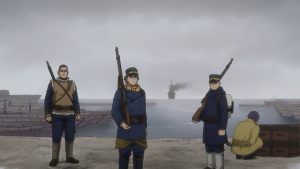 It all adds up to me being stoked to have this series back, a blessed relief from a year of mediocrity and homogeneity for anime. That Python-esque hybrid of the highbrow and lowbrow is fully on display in the third season premiere. Gags like Sugimoto constantly showing photos of a fundoshi-clad Tanigaki instead of Asirpa (why does Sugimoto have those photos, anyway – and so many of them?), are played off against the seriousness of the task at-hand – finding the abducted Asirpa, somewhere in the wilds of Sakhalin with Kiroranke.
It all adds up to me being stoked to have this series back, a blessed relief from a year of mediocrity and homogeneity for anime. That Python-esque hybrid of the highbrow and lowbrow is fully on display in the third season premiere. Gags like Sugimoto constantly showing photos of a fundoshi-clad Tanigaki instead of Asirpa (why does Sugimoto have those photos, anyway – and so many of them?), are played off against the seriousness of the task at-hand – finding the abducted Asirpa, somewhere in the wilds of Sakhalin with Kiroranke.
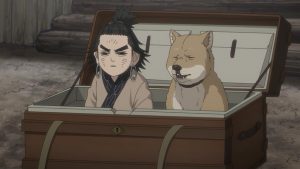 If you’ve seen the excellent anime film Giovanni’s Island, you know how the Japanese settlement of Sakhalin came to a jarring end – but the events depicted in Golden Kamuy are close to a half-century before that. Japan had emerged from the Russo-Japanese War with possession of half the island, and many Japanese traveled north to try and create farming communities there. But there were people on Sakhalin before the Japanese or even the Russians – the Ainu, which had split into three major groups. The Sakhalin Ainu developed a distinct culture, more dependent on fishing than the Hokkaido and Chishima groups.
If you’ve seen the excellent anime film Giovanni’s Island, you know how the Japanese settlement of Sakhalin came to a jarring end – but the events depicted in Golden Kamuy are close to a half-century before that. Japan had emerged from the Russo-Japanese War with possession of half the island, and many Japanese traveled north to try and create farming communities there. But there were people on Sakhalin before the Japanese or even the Russians – the Ainu, which had split into three major groups. The Sakhalin Ainu developed a distinct culture, more dependent on fishing than the Hokkaido and Chishima groups.
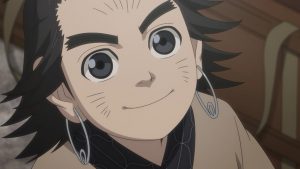 One thing all the Ainu groups have in common, of course, is persecution by their respective governments in the past few centuries – persecution intent on eliminating their culture both in Japan and on Sakhalin. Exposing this is Noda-sensei’s ultimate theme with Golden Kamuy to be sure, and he spares no detail in making sure he depicts the Ainu culture as accurately as possible. He works with an Ainu linguistics professor on the manga, and for this season, Geno Studio has brought in a language expert of their own – a Russian linguist. And the Russian language is all over the first episode of the season.
One thing all the Ainu groups have in common, of course, is persecution by their respective governments in the past few centuries – persecution intent on eliminating their culture both in Japan and on Sakhalin. Exposing this is Noda-sensei’s ultimate theme with Golden Kamuy to be sure, and he spares no detail in making sure he depicts the Ainu culture as accurately as possible. He works with an Ainu linguistics professor on the manga, and for this season, Geno Studio has brought in a language expert of their own – a Russian linguist. And the Russian language is all over the first episode of the season.
 Cikapasi and Ryu have stowed away to Sakhalin along with Sugimoto, Tanigaki, Tsukishima and Koito (who’s none too thrilled to see them). Cikapasi has hitched his sled to Tanigaki to be sure, and Tanigaki points out that the boy could be useful in gaining the trust of the Ainu on Sakhalin. Indeed he does prove useful as soon as the little group, believing they’re hot on Asirpa’s trail, turns out to have been following Enonoka (Ichinose Kana), an Ainu girl about Cikapasi’s age who’s fallen from her grandfather’s sled. The woods are especially dangerous this time of year, and not because of CGI bears – it’s wolverines (not CGI) that the locals are really frightened of. And indeed, they do have a rep as one of the pound-for-pound nastiest animals on Earth.
Cikapasi and Ryu have stowed away to Sakhalin along with Sugimoto, Tanigaki, Tsukishima and Koito (who’s none too thrilled to see them). Cikapasi has hitched his sled to Tanigaki to be sure, and Tanigaki points out that the boy could be useful in gaining the trust of the Ainu on Sakhalin. Indeed he does prove useful as soon as the little group, believing they’re hot on Asirpa’s trail, turns out to have been following Enonoka (Ichinose Kana), an Ainu girl about Cikapasi’s age who’s fallen from her grandfather’s sled. The woods are especially dangerous this time of year, and not because of CGI bears – it’s wolverines (not CGI) that the locals are really frightened of. And indeed, they do have a rep as one of the pound-for-pound nastiest animals on Earth.
 Enonoka may be the wrong girl, but she has seen the right one – and her tip leads the group (renting her grandfather’s sled) to the Russian village to the north. A haven of ex-prisoners, it’s a rough-and-tumble sort of place. But they don’t get much more rough-and-tumble than Sugimoto, and he’s particularly ill-tempered at having lost Asirpa. He roughs up one of the locals in the tavern, which eventually leads to the owner kidnapping Enonoka’s isohseta (lead sled dog), which he says he’ll return if Sugimoto takes the place of the man he beat up in the upcoming stenka. And if there’s ever been an event custom-made for Golden Kamuy, it’s the stenka.
Enonoka may be the wrong girl, but she has seen the right one – and her tip leads the group (renting her grandfather’s sled) to the Russian village to the north. A haven of ex-prisoners, it’s a rough-and-tumble sort of place. But they don’t get much more rough-and-tumble than Sugimoto, and he’s particularly ill-tempered at having lost Asirpa. He roughs up one of the locals in the tavern, which eventually leads to the owner kidnapping Enonoka’s isohseta (lead sled dog), which he says he’ll return if Sugimoto takes the place of the man he beat up in the upcoming stenka. And if there’s ever been an event custom-made for Golden Kamuy, it’s the stenka.
 I still can’t quite grok the fact that Golden Kamuy is a hit – it’s too weird, too esoteric, too generally uncommercial to succeed as an anime. And yet, somehow, it has. I don’t know why, but I’m heartily glad of it because shows like this make anime seasons. It seems to be more popular then ever in fact, given the level of merchandising associated with the series and the disc sales of the most recent OVA. It’s a treasure trove of riches to rival the gold everyone is searching for – a tremendous cast of characters (and seiyuu), a brilliant overarching plot, cultural insight and social activism, hilarious humor. As long as Noda keeps writing I suspect anime will keep adapting – and you can bet your ass I’ll keep watching.
I still can’t quite grok the fact that Golden Kamuy is a hit – it’s too weird, too esoteric, too generally uncommercial to succeed as an anime. And yet, somehow, it has. I don’t know why, but I’m heartily glad of it because shows like this make anime seasons. It seems to be more popular then ever in fact, given the level of merchandising associated with the series and the disc sales of the most recent OVA. It’s a treasure trove of riches to rival the gold everyone is searching for – a tremendous cast of characters (and seiyuu), a brilliant overarching plot, cultural insight and social activism, hilarious humor. As long as Noda keeps writing I suspect anime will keep adapting – and you can bet your ass I’ll keep watching.




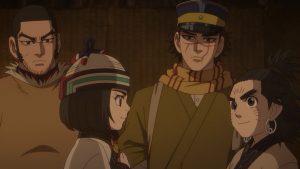
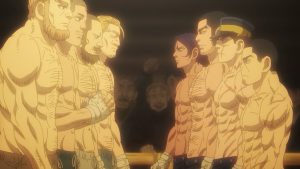


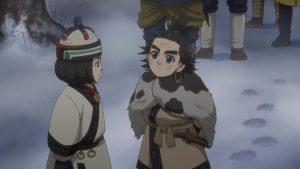


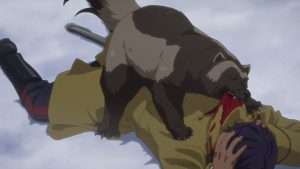
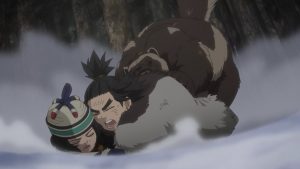



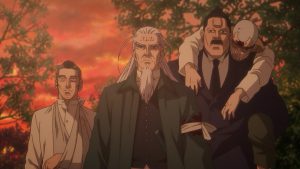
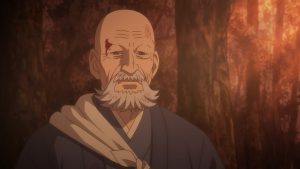


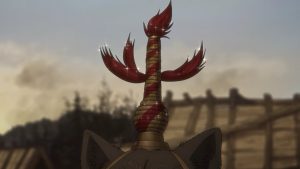










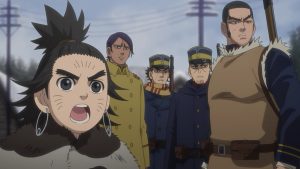



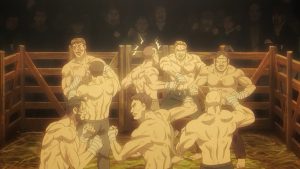


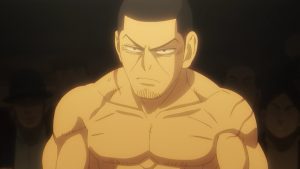
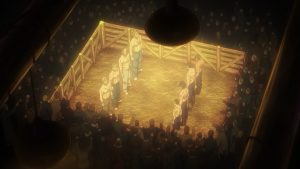

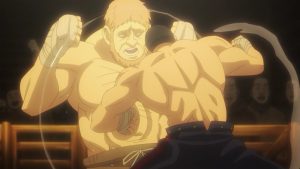





sweejen
October 7, 2020 at 2:08 amA small joy to hold onto in Shitshow 2020! I’m so glad it’s back.
bennydelon
October 7, 2020 at 2:34 amThey photos were taken in season 2 by the photographer who had an old photo of Hijikata. For some reason he wanted to take sexy photos of Tanigaki. I never questioned why, because it’s Golden Kamuy after all, but I guess the joke paid off in this episode.
Guardian Enzo
October 7, 2020 at 8:17 amBut why does Sugimoto have them?
slazer
October 7, 2020 at 4:08 amAnd we’re back! I loved the first two seasons but I’d forgotten just how absurd and how compelling the whole story was so I’m happy it’s back. Looking forward to your coverage of it this season, Enzo.
eo
October 7, 2020 at 5:15 amthanks! guess i’ll binge through s01 & 02 asap
Gemsy-chan
October 7, 2020 at 9:38 amSo glad for Golden Kamuy to be back.
I don’t like being picky but wanted to point out that its photos of Tanigaki he shows not Shiraishi,
Guardian Enzo
October 7, 2020 at 10:51 amLOL, yeah, too many names to keep straight in my head.
Princess Usagi
October 7, 2020 at 10:59 amI am so excited for season 3! I appreciate the detail the mangaka puts into portraying Ainu culture in a beautiful rather than stereotyped way and the richness from the inclusion of Russian and Ainu languages. It gives more of an authentic/respectful diversity than I am used to seeing in anime! Out of curiosity, what is the general Japanese audience response to Golden Kamuy? (I wonder with the country’s history of treatment of the Ainu, if there is a different response from the West, although the West has it’s own issues in that category).
Guardian Enzo
October 7, 2020 at 6:22 pmAs I said, the series is surprisingly popular – more surprising with the anime. I haven’t seen any outrage over the Ainu stuff, which is rather surprising too come to think of it. I think most fans just kind of don’t think about it.
1 0
October 14, 2020 at 7:51 amI think that the reason behind GK’s popularity is just what you said: the prevailing homogeneity and mediocrity in anime nowadays. In a landscape like this, Golden Kamuy stands out like a sore thumb. I know there are many reasons to be pessimistic about the future of anime considering its target audience’s love for the formulaic (and I don’t exclude myself from that, I admit), but shows like this one prove that this isn’t all there is to it. I feel like there’s a thirst for the original, the uncommon, the innovative, and GK answers it perfectly. Both the anime and the manga have a boldness not often seen in the media; I mean, how many series can manage to infodump the way this one does, and how many have done it in such a compelling way? I also believe that, to a far more restrained level, this is also why BnHA is such a hit. It plays many of shounen’s old tropes straight, but also gives a new spin to many of them. Sure, there are still series like Black Clover around that will probably make it to the hundreds of episodes, but shows like GK still allow me to have hope. A sliver of it.
Guardian Enzo
October 14, 2020 at 9:09 amWell, that may very well be true. But if so, why aren’t there more like it? Believe me, there are plenty of manga that would scratch that same itch if adapted. Is the issue that there’s an appetite for it, but the appetite is small enough that one snow can sate it? Or is anime just missing the boat with this audience?
1 0
October 14, 2020 at 10:29 amI think it is a corporate thing, to be honest. Just like with Hollywood, there’s a tendency to bet on what’s surely profitable. That’s why light novel adaptations – and superhero movies – are out by the dozens every year, I think, despite having plots and structures that are painfully formulaic. There’s money to be made off of it, and this is not exactly certain with those oddballs. I think that seeing the failures of those that did try to go against the tide at every turn – such as Manglobe – scared off the industry. Maybe successes like this one will serve to reverse this. We’ll see.